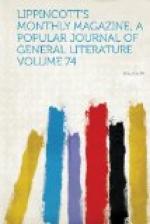The dresses of the dancers were varied and splendid. Most of them wore the usual trousers or Indian leggings of blue cloth, cut off below the hips, with another cloth for the loins, and those that had no trousers had their legs painted. Embroidered blankets of blue or red cloth, moccasins, belts, tobacco-pouches, and cases for scalping-knives, all beaded, with glittering arms and tomahawks, hung about them everywhere, but the chief piece of finery was the war-bonnet; and a tremendous show it made. A turban of fur or scarlet cloth went round the head, adorned with tall eagles’ feathers in a crown, such as we see upon the wooden figures before cigar-shops, and from this hung down a long piece of scarlet cloth, about a quarter of a yard wide, and long enough to trail on the ground a yard or two behind. This was ornamented with a fringe of eagles’ feathers on each edge, like the backbone of a fish, and as it waved about nothing could be more superb. The savage dandies were evidently proud of their appearance, and to say that they were “got up regardless of expense” was simply a fact, for their wardrobes must have cost considerable sums—half a dozen ponies at least. Standing in a circle, they danced, shouting and singing. It was a slow measured step, but no more like dancing than their singing was like singing. Another gorgeous circle was formed on the other side of the stockade, and both parties kept up this weird dance with great gravity. One young fellow laughed, twisted about, and conducted himself a little like a harlequin. All held the hands upon the haunches and bent forward. This was called an Omaha dance. After a while all stopped dancing, and one of the squad of chiefs rode into the circle and began to relate his experience, while at every pause the emphasis was given by a strange roll of the drum. He was telling some savage exploit, the interpreter said,




